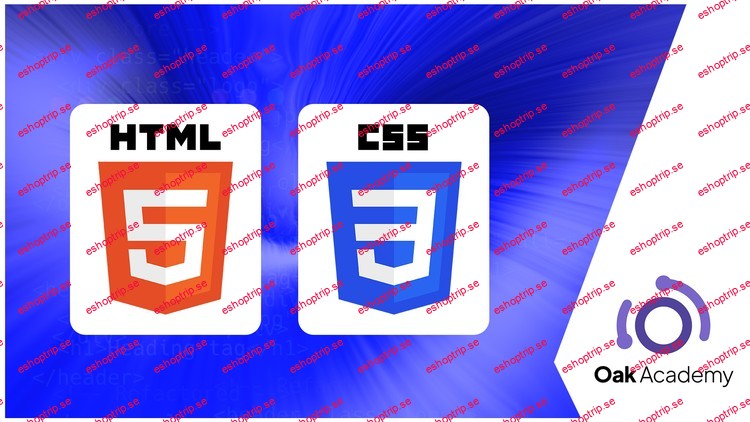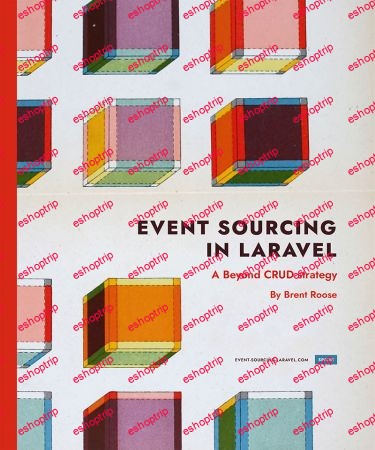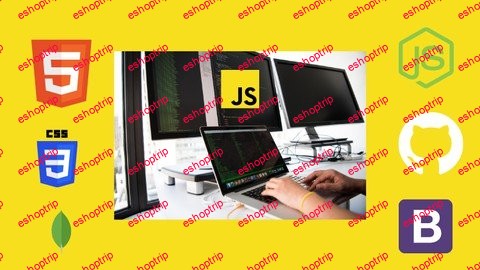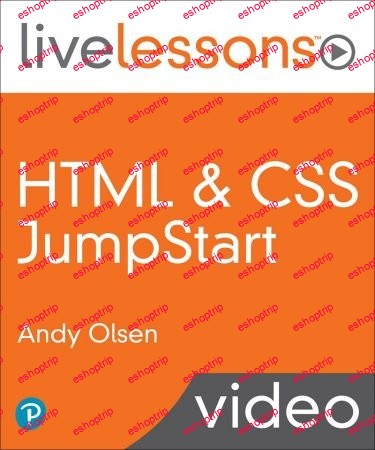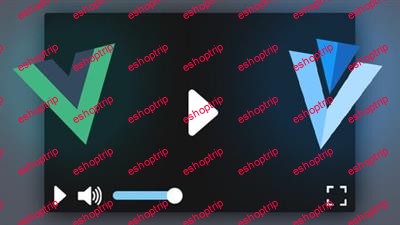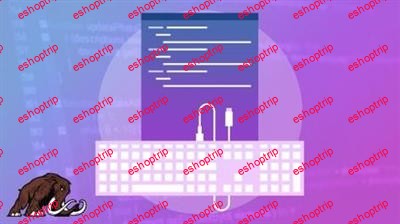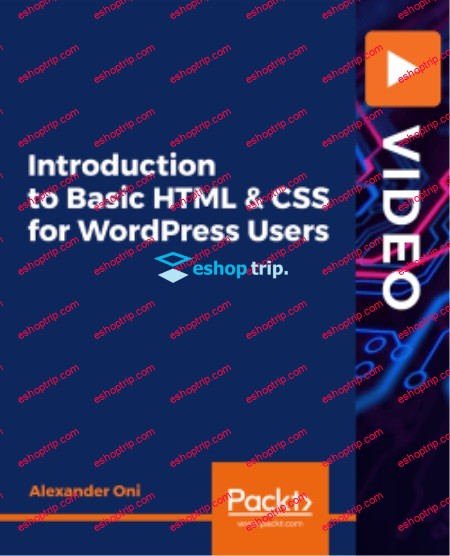Published 7/2024
Duration: 13h26m | Video: .MP4, 1920×1080 30 fps | Audio: AAC, 44.1 kHz, 2ch | Size: 5.28 GB
Genre: eLearning | Language: English
HTML and Advanced CSS Course. Learn HMTL CSS with CSS Animations, Flexbox, Grid and build responsive portfolio web sites
What you’ll learn
What is HTML and how to use it?
Creating a web page with HTML fundamentals.
What is CSS and how to use it?
The most used features of CSS from the past to the present and modern CSS features.
Creating web pages using HTML and CSS.
CSS, Css3 for everyone from scratch
We will improve our knowledge step by step by learning the basics of CSS
We will learn to place pages in the easiest way by talking about all layout models in CSS
Create a beautiful, responsive landing page for any one
It will be much easier to prepare web pages with Grid CSS and Flexbox features
Learning how to code HTML without also learning CSS is like learning how to read but not write.
Consider the devices that you use to access the internet on a daily basis. You’ll notice that there isn’t a standard screen size.
What is Cascading Style Sheets (CSS)? CSS or Cascading Style Sheets is a style sheet language used to style markup language.
What careers use CSS? CSS applies to any career that involves web development.
Front-end web developers use CSS with HTML and JavaScript to build front-end web applications that run in the browser.
Web designers create the templates, mockups, and styles for a website using HTML and CSS that web developers use to build websites.
Requirements
This course is ideal for volunteers who want to become a web developer but don’t know how to get started. You don’t need to know anything. Just be willing.
We preferred macOs but this is not mandatory. You can prefer to use other Operating Systems.
Having a working computer with 8 GB RAM or higher and internet connection
Desire to learn Web Application Development
Nothing else! It’s just you, your computer, and your ambition to get started today
Description
Hi there,
Welcome
to Built a Real-World Website with HTML and CSS
2024
Build static web sites from scratch with HTML and CSS| Learn HTML fundamentals, CSS fundamentals and other.
Hypertext markup language (
HTML
) is the foundational computer code used to create web pages. HTML is used by web developers, email marketers, and many others for various purposes, from adding character to text fonts to creating entire sites. Without HTML, none of it would be possible. HTML training can provide you with fundamental web building knowledge.
As the foundational language of the entire World Wide Web, working knowledge of HTML is essential for any profession that involves any sort of web developing. Whether you develop web sites or apps that use PHP, Java, or JavaScript, it is necessary to first understand HTML.
Learning how to code HTML without also learning CSS is like learning how to read but not write. All of your hard web development work is lost if you don’t optimize it for different screen sizes.
Consider the devices that you use to access the internet on a daily basis. You’ll notice that there isn’t a standard screen size. Without CSS, rendering a website’s text, layout, and design for these discrepancies in screens would be impossible. CSS is the backbone of all website styling work, and is rightfully considered a cornerstone of internet technology.
In this course, you will learn to develop a web site with
HTML & CSS
from scratch.
If you are thinking to start to learn
HTML & CSS
, this course is the best match for you.
We have explained
HTML CSS
from beginner to all levels. We have explained all the topics as simple as possible with examples, slides, and diagrams.
We have created a lot of projects while explaining the subjects. Because we believe that applied educations are much more useful than other teaching methods.
Let’s talk about the course curriculum now.
First, we will see what we will learn in the course. Then we will learn the basics of HTML. Here we will see all the html tags used from past to present. Then we will start to see semantic html tags. We will learn why and how to use them. We will create a website with just HTML only. Then we will start to see CSS topics. First we will see basic CSS topics. Then we will learn modern CSS features.
The appearance of a website is very important nowadays. The layout of websites is very important to create beautiful websites. We have a section where we will learn how to do this. In addition, responsive designs are very important today. The sites we have made should have a proper image on all screen sizes. There is a method we can apply this for all screens, this method is called media query. We will also learn how to use them.
We will also learn
CSS animations
to create small animations on our pages. To reinforce what we have learned throughout the course, we will design a nice portfolio site together with you. Thus, we will complete our course.
After taking your course, there will be no subject that we have not seen from basic
HTML and CSS
topics. With what you learn in this course, you will be able to design the site you want. Besides all these, we will use Visual Studio Code IDE to create your applications. We will also learn how to use it.
No Previous Knowledge is needed!
You don’t need to have previous knowledge about HTML and CSS.
This course will take you from a beginner to a more advanced level with hands-on examples.
You will be confident in using
HTML and CSS
, and if you ever get stuck, we will be there to help.
Learn by doing!
So we have made this course as simple as possible in order to take you through step by step so you can feel confident and get a truly good understanding of how to utilize HTML and CSS. In this course, we will be teaching HTML and CSS by creating various projects.
In this tutorial you will learn;
How to create Web Site with
HTML & CSS
Most important
HTML & CSS
topics.
How to create responsive designs for websites
How to easily build the largest and most advanced web site using
HTML & CSS
What is HTML?
HTML (HyperText Markup Language) is a standard markup language used to create the structure and content of web pages. It consists of a set of tags and attributes that define the structure and layout of the content within a web page. HTML tags are used to mark up elements such as headings, paragraphs, lists, links, images, forms, and other types of content.
HTML documents are text files with a .html or .htm extension and can be created using any text editor. These documents are interpreted by web browsers, which render the content according to the instructions provided by the HTML markup.
HTML provides a way to organize and structure content on the web, allowing developers to create documents that are easily understood by both humans and machines. It is often used in conjunction with other web technologies such as CSS (Cascading Style Sheets) for styling and JavaScript for interactivity, to create dynamic and visually appealing web pages.
What is CSS?
CSS (Cascading Style Sheets) is a style sheet language used to describe the presentation of a document written in markup languages such as HTML and XML. CSS defines how elements of a web page should be displayed, including aspects like layout, colors, fonts, and spacing. By separating the presentation style from the content of the document, CSS enables greater flexibility and control over the visual appearance of web pages.
CSS works by associating styles with HTML elements through selectors. Selectors target specific elements in the HTML document, and styles are applied to those elements according to the rules defined in the CSS stylesheet. CSS styles can be applied inline within HTML elements, internally within the HTML document using
<style>
tags, or externally in separate CSS files linked to the HTML document using
<link>
tags.
What can we do using HTML and CSS?
HTML and CSS are fundamental technologies for web development and together they enable developers to create rich and interactive web experiences. Here are some of the things you can do using HTML and CSS
Structuring Content
: HTML provides a way to structure the content of a web page using elements like headings, paragraphs, lists, tables, and more. CSS allows you to control the layout and appearance of these elements, including their size, position, and spacing.
Styling
: CSS allows you to style the visual presentation of HTML elements, including properties like colors, fonts, backgrounds, borders, and shadows. With CSS, you can create visually appealing designs and ensure consistency across multiple pages of a website.
Responsive Design
: CSS provides features like media queries that enable you to create responsive layouts that adapt to different screen sizes and devices. This allows your website to provide an optimal viewing experience on desktops, tablets, and smartphones.
Animation and Transitions
: CSS includes properties for creating animations and transitions, allowing you to add movement and interactivity to elements on a web page. This can be used to create engaging user interfaces and improve the user experience.
Flexibility
: HTML and CSS provide flexibility in terms of design and layout. You can create complex page layouts, implement custom navigation menus, design forms for user input, and more, all using these technologies.
Accessibility
: HTML and CSS include features that support accessibility, making it possible to create websites that are usable by people with disabilities. This includes features like semantic HTML markup, proper use of headings and landmarks, and providing alternative text for images.
Integration with Other Technologies
: HTML and CSS can be integrated with other web technologies like JavaScript, allowing you to create dynamic and interactive web applications. JavaScript can be used to add behavior to HTML elements, manipulate the DOM, and handle user interactions.
Overall, HTML and CSS are powerful tools for creating visually appealing, responsive, and accessible websites and web applications. They form the foundation of web development and are essential skills for anyone working in the field.
How does HTML and CSS work?
HTML (HyperText Markup Language) and CSS (Cascading Style Sheets) work together to create and style web pages. Here’s how they work
HTML
: HTML is used to create the structure and content of a web page. It consists of a set of elements, each represented by a tag, which define different parts of the content such as headings, paragraphs, lists, links, images, and more. HTML provides the semantic structure of the document, organizing the content in a meaningful way. When a web browser parses an HTML document, it interprets these tags and renders the content accordingly, displaying it on the screen.
CSS
: CSS is used to style the appearance of the HTML elements defined in the document. It allows you to specify properties such as colors, fonts, margins, padding, borders, and more for individual or groups of elements. CSS rules are applied to HTML elements using selectors, which target specific elements or groups of elements. When a web browser renders an HTML document, it applies the styles defined in the CSS to the corresponding HTML elements, affecting their visual presentation.
Integration
: HTML and CSS are often integrated by linking a separate CSS file to the HTML document using the
<link>
element in the
<head>
section of the HTML document. This allows for separation of concerns, with HTML defining the structure and content of the page, and CSS defining the presentation and styling. Additionally, inline styles and internal styles can also be used to apply CSS directly within HTML elements or within the HTML document itself.
Overall, HTML and CSS work together to create visually appealing and well-structured web pages by defining both the content and presentation of the page.
What is responsive design?
Responsive design is a new type of design intended to respond to the platform and environment that a user is on. When HTML was created, most people used PCs. Today, people can browse a website on a PC, phone, tablet, or even a game console. In the past, developers created separate sites for “desktop” and “mobile.” While it worked, it wasn’t easy to maintain. Rather than creating separate sites, responsive design generates the site based on the environment it detects. This greatly reduces the amount of development and maintenance for the site. Responsive design is generally achieved with a combination of HTML, CSS, and Javascript.
Is it hard to learn HTML and CSS?
Learning HTML and CSS is often considered one of the easier aspects of web development compared to other programming languages and technologies. Here’s why
Simple Syntax
: HTML and CSS have relatively simple syntax compared to other programming languages. HTML consists of a set of tags, while CSS uses property-value pairs. This simplicity makes it easier for beginners to understand and learn.
Immediate Results
: With HTML and CSS, you can see the results of your work immediately in a web browser. This instant feedback can be motivating and helps reinforce learning.
Abundance of Learning Resources
: There are countless tutorials, guides, videos, and online courses available for learning HTML and CSS, many of which are free. Additionally, there are supportive online communities where you can ask questions and get help if you’re stuck.
Progressive Learning Curve
: You can start with the basics of HTML and CSS and gradually build upon your knowledge as you become more comfortable. You don’t need to learn everything all at once; you can start by creating simple web pages and gradually tackle more complex concepts and projects.
Widespread Use
: HTML and CSS are the foundation of web development and are used extensively in building websites and web applications. This means that there are ample opportunities to practice and apply your skills in real-world projects.
While HTML and CSS are generally considered easier to learn compared to other programming languages, mastering them and becoming proficient may still require time, practice, and dedication. However, with persistence and the right resources, many people find that they can quickly grasp the fundamentals and begin creating their own web pages and designs.
At the end of the course
By the end of the course, You will be able to start building your own website using HTML and CSS.
Why would you want to take this course?
Our answer is simple: The quality of teaching.
OAK Academy
based in
London
is an online
education company
. OAK Academy gives education in the field of I
T, Software, Design, development
in
English, Portuguese, Spanish, Turkish
and a lot of different language on Udemy platform where it has over
1000 hours
of video education lessons. OAK Academy both increase its education series number by publishing new courses, and it makes students aware of all the innovations of already published courses by upgrading.
When you enroll, you will feel the OAK Academy`s seasoned developers expertise. Questions sent by students to our instructors are answered by our instructors within
48 hours at the latest
.
Fresh Content
It’s no secret how technology is advancing at a rapid rate. New tools are released every day, and it’s crucial to stay on top of the latest knowledge for being a better React developer. You will always have up-to-date content for this course at
no extra charge
.
Video and Audio Production Quality
All our content is created/produced as
high-quality video/audio
to provide you with the best learning experience.
You will be,
· Seeing clearly
· Hearing clearly
· Moving through the course without distractions
You’ll also get
Lifetime Access to The Cours
Fast & Friendly Support in the Q&A section
Udemy Certificate of Completion Ready for Download
Dive in now into; “Built a Real-World Website with HTML and CSS” course.
We offer
full support
, answering any questions.
See you on the other side!
Who this course is for
Anyone who wants to learn to HTML and CSS.
Programmers who are interested in building websites with HTML and CSS.
Anyone who has no previous Web Development coding experience but wants to become an expert
A total beginner, with a curious mind and wants to be a web developer
Anyone planning a job transformation and wants to become a web developer
Homepage
https://www.udemy.com/course/html-and-css-complete-course-with-hands-on-portfolio-project
